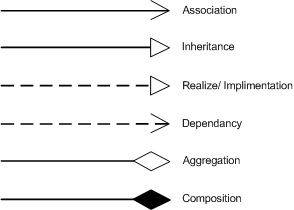Class Diagrams (p. 114)
Static structure of an object-oriented program containing
- attributes
- constructors
- methods
- relationships among classes and objects
May be
- created as a design or analysis doc before coding
- generated from existing source code
Relationships Between Classes
Two groups:
- class-level relationships
- inheritance
- implementation
- instance-level relationships
- dependencies
- association
- aggregation
- composition
Class-Level Relationship
Inheritance is also called generalization because the subclass/type is a specialized form of the superclass/type. The implementation relationship between a class and an interface means the class implements the interface.
Instance-Level Relationship

- Dependency
- points from the client element to the server element
- changes to the server may cause changes to the client
- Association
- family of links
- bi-directional (line)
- uni-directional (directed line)
- aggregation (includes composition aggregation)
- reflexive (on the same class)
- Can include:
- role names
- ownership indicators
- multiplicity
- visibility
- etc.
- family of links
- Aggregation
- specific binary association representing a part-whole or part-of relationship
- contained class does not have a strong lifecycle dependency on container
- a teacher has students
- destroying a teacher doesn't mean destroying students
- Composition
- aka composition aggregation
- stronger form of aggregation
- considered as a "physical containment" relationship
- when container is destroyed, contents are destroyed
Multiplicity Notations
| Notation | Meaning |
|---|---|
| 0 | No instances |
| 0..1 | No instance or 1 instance |
| 1 or 1..1 | Exactly 1 instance |
| 0..* or * | Zero or more instances |
| 1..* | 1 or more instances |